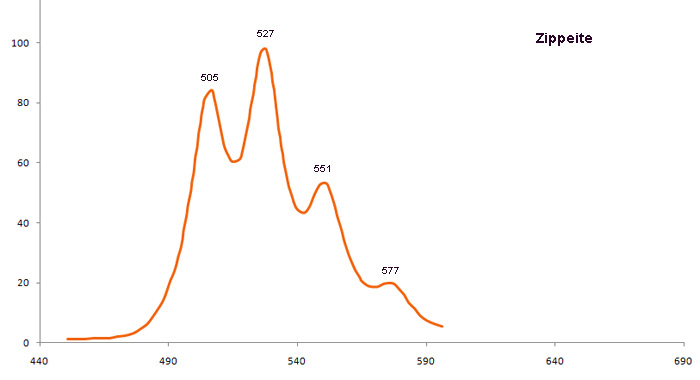Database of luminescent minerals
ZIPPEITE
Chemical formula: K (UO2)2(SO4)(OH)3 H2O
Family: Sulfates
Status: IMA-A
Crystal system : Monoclinic
Display mineral: NON
Luminescence:
Longwave UV (365nm) colors: |
Green , | ||
Intensity LW:Strong | |||
Shortwave UV (254nm) colors: |
Green , | ||
Intensity SW:Strong | |||
Do you have a photo of this mineral you would like to see in the gallery? Contact us!
Phosphorescence (in the common sense of the term) observable with the naked eye:
No phosphorescence visible to the naked eye under any type of UV
Comments:
Synthetic Cobalt and Nickel Zippeite both fluoresce.
Activator(s) and spectrum:
Activator(s): (UO2)2+ (ion Uranyle) intrinsèque ,
Peaks in the spectrum (nm):
505, 527, 551, 577

Col. G.Barmarin; Photo: G. Barmarin
Spectrum Galery:

 ...
...Comments on spectrum and activators:
Lifetime: 3μs @ 540nm;
Best localities for fluorescence (*):
- Sec. 35 mine, Grants, New Mexico, USA;
- Green River, Emery county, Utah, USA;
(*)The data are not exhaustive and are limited to a few remarkable localities for fluorescence
Bibliographic reference for luminescence:
- The Henkel Glossary of Fluorescent Minerals, Dr. Gerhard Henkel, Published by the FMS, 1989 ,
- Fluorescence: Gems and Minerals Under Ultraviolet Light, Manuel Robbins, 1994, Geoscience Press, ISBN 0-945005-13-X ,
- Luminescence Spectroscopy of Minerals and Materials, M. Gaft, R. Reisfeld, G. Panczer, Springer Editor, ISBN: 10 3-540-21918-8 ,
- Uranium minerals Website: http://www.uraniumminerals.com ,
- Introduction to radioactive minerals, Robert Lauf, Schiffer Publishing, 2008, ISBN 978-0-7643-2912-8 ,
Reference for luminescence on the Internet:
Mineralogical reference on the Internet:
 http://www.mindat.org/show.php?name=Zippeite
http://www.mindat.org/show.php?name=Zippeite
 http://webmineral.com/data/Zippeite.shtml
http://webmineral.com/data/Zippeite.shtml
Internet Search:
 Image search on 'Google Images'
Image search on 'Google Images'
 Search for documents in all languages on Google
Search for documents in all languages on Google
A request providing no result means only that no such reference exists in the database, but it does not mean that what you are looking for does not exist, just not to our knowledge. If you think you have found an error or omission, please let us know via the contact page being sure to cite the source of information.

